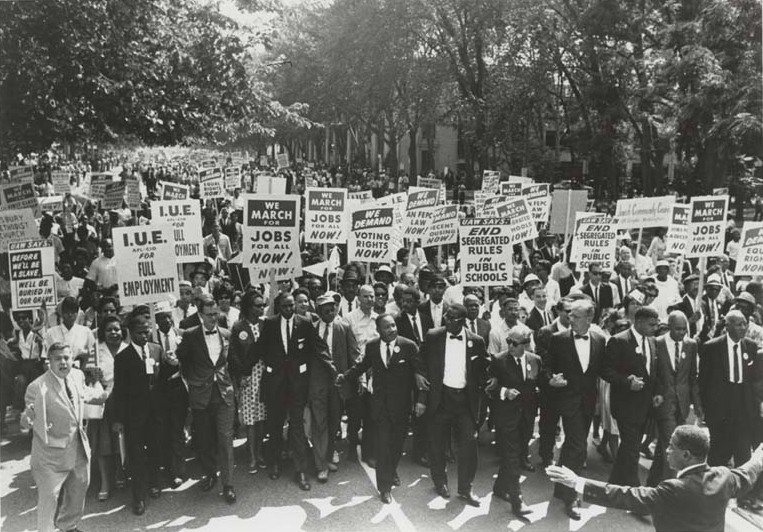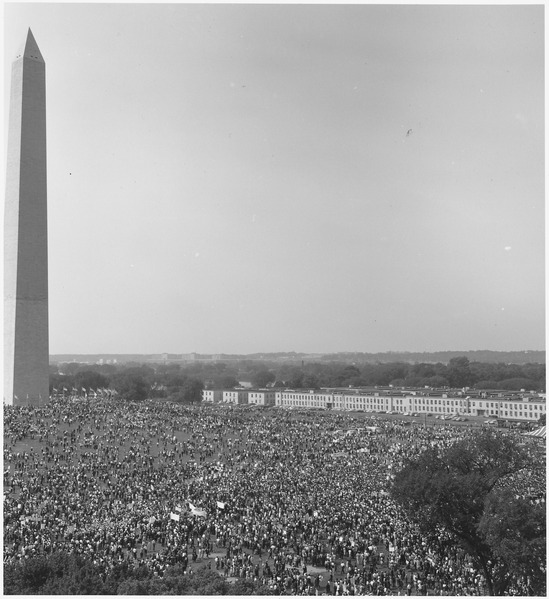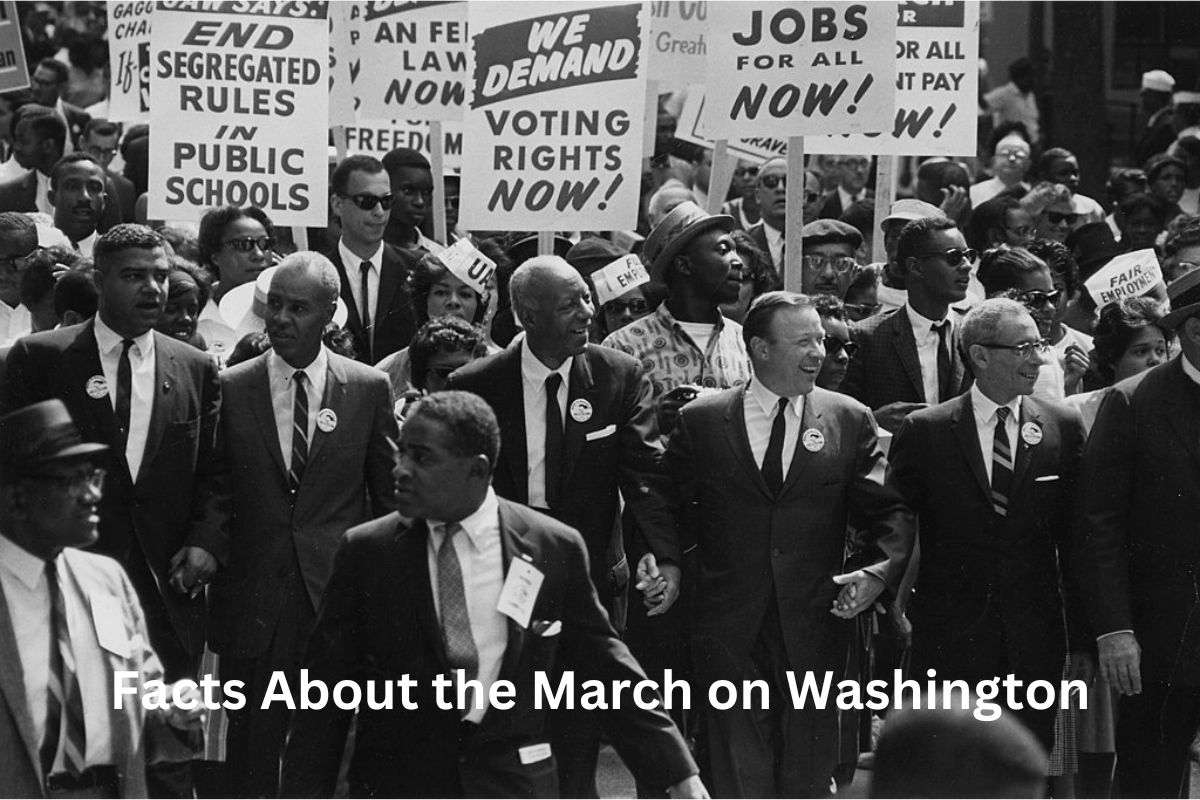The March on Washington for Jobs and Freedom, held on August 28, 1963, was a historic event in the civil rights movement of the United States.
Organized by a coalition of civil rights, labor, and religious organizations, the march aimed to advocate for civil and economic rights for African Americans, as well as to challenge racial segregation and discrimination.
With an estimated 250,000 participants, it became one of the largest political rallies for human rights in American history at that time.
The iconic “I Have a Dream” speech delivered by Dr. Martin Luther King Jr. during the march, along with the speeches of other civil rights leaders, galvanized support and helped bring about legislative changes.
The peaceful and inclusive nature of the march demonstrated the power of nonviolent protest and united diverse groups in their pursuit of justice and equality.
The impact of the March on Washington continues to resonate, serving as a symbol of collective action and inspiring subsequent activism in the ongoing struggle for civil rights.
March on Washington Facts
1. The March on Washington for Jobs and Freedom took place on August 28, 1963
The March on Washington for Jobs and Freedom, also known as the March on Washington, took place on August 28, 1963. It was a historic event that brought together a diverse coalition of civil rights, labor, and religious organizations.
Also Read: Facts About the Freedom Riders
The march aimed to address the pressing issues of racial inequality, economic disparity, and civil rights violations that African Americans faced during that time.

2. The march was organized by a coalition of civil rights, labor, and religious organizations
The march was organized by a coalition of prominent civil rights organizations, including the Southern Christian Leadership Conference (SCLC), led by Dr. Martin Luther King Jr., and the National Association for the Advancement of Colored People (NAACP), led by Roy Wilkins.
It also involved labor unions such as the Congress of Industrial Organizations (CIO) and religious organizations like the National Urban League.
3. The main goal of the march was to advocate for civil and economic rights for African Americans
The main goal of the March on Washington was to advocate for civil and economic rights for African Americans.
Also Read: Facts About the Civil Rights Act of 1964
The organizers sought to address various issues, including racial segregation, discriminatory hiring practices, inadequate access to education and voting rights, and police brutality.
By focusing on both jobs and freedom, the march aimed to highlight the economic inequalities faced by African Americans and the need for comprehensive civil rights legislation.
4. The march attracted an estimated 250,000 participants
The March on Washington attracted an estimated 250,000 participants, making it one of the largest political rallies for human rights in U.S. history at that time.
People from all walks of life, including African Americans and individuals from various racial, ethnic, and religious backgrounds, came together to show their support for equality and justice.
The massive turnout demonstrated the widespread commitment to the civil rights movement and created a powerful visual representation of solidarity.
5. The most famous part of the march was the iconic “I Have a Dream” speech delivered by Dr. Martin Luther King Jr
One of the most memorable moments of the March on Washington was the iconic “I Have a Dream” speech delivered by Dr. Martin Luther King Jr. from the steps of the Lincoln Memorial.
In his impassioned speech, Dr. King eloquently articulated his vision of a future where racial harmony, equality, and justice prevailed. His words resonated deeply with the crowd and with millions of people across the nation, ultimately becoming one of the most significant speeches in American history.

6. Other prominent civil rights leaders and activists also spoke at the march, including John Lewis, A. Philip Randolph, Whitney Young, and Roy Wilkins
While Dr. King’s speech is often the most remembered, other influential civil rights leaders and activists also spoke at the march.
John Lewis, a young leader of the Student Nonviolent Coordinating Committee (SNCC), delivered a stirring speech emphasizing the importance of voting rights and urging the crowd to continue their peaceful struggle.
A. Philip Randolph, a prominent labor and civil rights leader, was one of the key organizers of the march and delivered an impassioned address demanding economic justice.
Other notable speakers included Whitney Young, the executive director of the National Urban League, and Roy Wilkins, the executive director of the NAACP.
Together, these speeches reinforced the message of unity, justice, and equality and highlighted the collective effort behind the civil rights movement.
7. The march was a peaceful demonstration, emphasizing nonviolent protest and unity
The March on Washington was a peaceful demonstration that emphasized nonviolent protest and unity among diverse groups of people.
The organizers and leaders of the march were committed to the principles of nonviolence, inspired by the teachings of Mahatma Gandhi and the philosophy of civil disobedience.
This commitment to peaceful protest was a strategic choice aimed at garnering widespread support and challenging the negative narratives surrounding the civil rights movement.
8. The event played a crucial role in raising public awareness and support for civil rights legislation
The peaceful and impactful nature of the March on Washington played a significant role in raising public awareness and support for civil rights legislation.
The march garnered extensive media coverage, both nationally and internationally, bringing the issues of racial inequality and civil rights violations to the forefront of public consciousness.
This heightened awareness and the subsequent pressure from the public contributed to the passage of landmark legislation, including the Civil Rights Act of 1964 and the Voting Rights Act of 1965, which aimed to dismantle segregation, protect voting rights, and address systemic discrimination.
9. The success of the March on Washington contributed to the overall momentum of the civil rights movement
The success of the March on Washington had a ripple effect on the civil rights movement. It inspired and invigorated activists, communities, and organizations across the United States.
The march demonstrated the power of collective action and peaceful protest, providing a blueprint for future demonstrations and activism. It served as a catalyst for further civil rights campaigns and protests in the years that followed, helping to advance the cause of racial justice and equality.
10. The impact of the March on Washington continues to be felt today
The impact and legacy of the March on Washington continue to be felt today. It stands as a powerful symbol of the tireless struggle for civil rights, social justice, and equality.
The march serves as a reminder of the transformative power of grassroots organizing, nonviolent resistance, and the ability of ordinary individuals to effect meaningful change.
The principles and spirit of the March on Washington continue to inspire activists and advocates fighting for justice in various social and political movements. It remains an indelible part of American history and a testament to the ongoing pursuit of equality for all.
